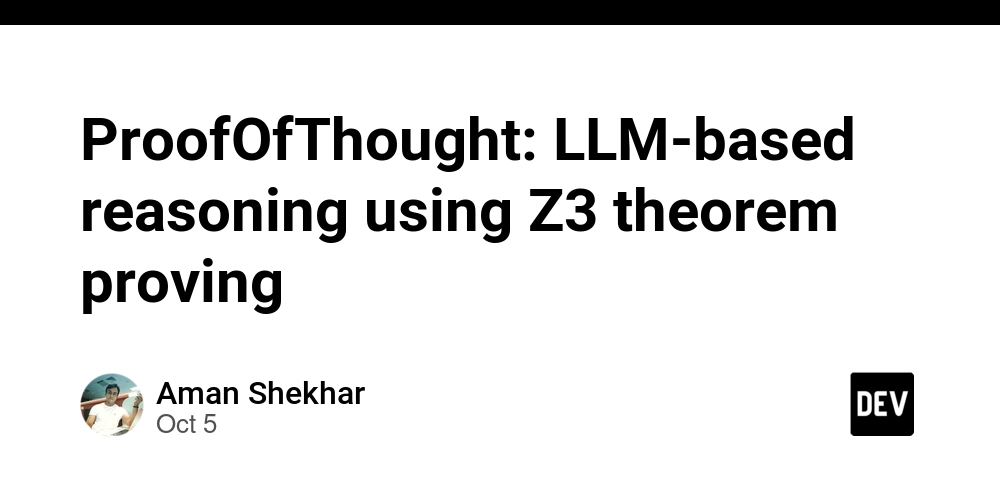In recent years, the emergence of Large Language Models (LLMs) has revolutionized the way we interact with and leverage artificial intelligence. However, while LLMs excel at generating coherent text, they often struggle with reasoning and logical inference tasks. Enter ProofOfThought—an innovative approach that combines the power of LLMs with formal verification techniques using the Z3 theorem prover. This synthesis allows developers to create systems that not only generate text but also reason about it coherently. In this blog post, we will explore the architecture of ProofOfThought, its implementation, and practical applications, equipping you with actionable insights to leverage this technology in your own projects.
Understanding the Components of ProofOfThought
Large Language Models (LLMs)
LLMs, such as OpenAI’s GPT and Google’s BERT, have excelled in natural language processing (NLP) tasks. They are trained on vast amounts of text data, enabling them to generate human-like responses. However, their inherent limitations lie in complex reasoning tasks, where logical consistency and correctness are paramount. For instance, while an LLM can generate plausible answers to questions, it may fail to validate these answers against a set of logical constraints.
The Role of Z3 Theorem Prover
Z3 is a high-performance theorem prover developed by Microsoft, which serves as a tool for checking the satisfiability of logical formulas over one or more theories. By integrating Z3 with LLMs, we can not only generate responses but also validate them against logical constraints. This integration enables a more robust reasoning mechanism that can be vital in various applications, from legal reasoning to programming assistance.
Architectural Overview of ProofOfThought
The architecture of ProofOfThought can be broken down into several key components:
- Input Processing: User queries are pre-processed to extract relevant information, which is then transformed into a format suitable for LLMs and Z3.
- LLM Integration: The LLM generates an initial response based on the processed input, creating a plausible answer that may or may not be logically sound.
- Theorem Proving with Z3: The generated response is subsequently passed to Z3, where logical checks are performed to ensure consistency and correctness.
- Output Generation: Based on the results from Z3, the system either confirms the generated response or prompts the LLM to revise it, creating a feedback loop for improved accuracy.
This architecture not only promotes a more interactive experience but also ensures that the generated content adheres to logical standards.
Implementation Steps for Developers
To implement ProofOfThought in your projects, follow these steps:
- Set Up Your Environment: Ensure you have Python installed along with the necessary libraries, such as Transformers for LLMs and Z3 for theorem proving. You can install these using pip:
pip install transformers z3-solver
- Load Your LLM: Use the Transformers library to load a pre-trained LLM. Here’s an example using Hugging Face’s Transformers:
from transformers import pipeline
llm = pipeline('text-generation', model='gpt-3')
- Integrate Z3: Initialize Z3 and define your logical constraints. Here’s a simple example:
from z3 import *
def check_consistency(statement):
s = Solver()
# Example logical constraints
x = Bool('x')
s.add(x == True) # Replace with your own logic
return s.check() == sat
- Create the User Interaction Loop: Set up a mechanism to handle user queries, generate responses, and validate them:
while True:
user_input = input("Ask a question: ")
response = llm(user_input)
if check_consistency(response[0]['generated_text']):
print("Answer:", response[0]['generated_text'])
else:
print("The response is not logically consistent. Please rephrase.")
Real-World Applications
Legal Reasoning
One of the most compelling applications of ProofOfThought is in the legal domain. Legal texts are intricate and often laden with logical nuances. By employing LLMs for generating legal arguments and Z3 for validating them, law firms can expedite research and ensure the validity of arguments presented in court.
Programming Assistance
Another exciting application lies in programming. Imagine an AI-powered assistant that not only writes code snippets but also verifies their correctness. By integrating ProofOfThought into IDEs, developers can receive real-time feedback on code logic, reducing errors and improving productivity.
Performance Considerations
When implementing ProofOfThought, consider the following performance optimization techniques:
- Batch Processing: If you anticipate high traffic, batch process multiple queries to minimize Z3’s overhead.
- Caching Results: Store frequently checked logical statements to avoid redundant computations.
- Asynchronous Processing: Use asynchronous programming techniques to ensure that the user experience remains smooth, even during lengthy validation processes.
Security Implications
As with any AI system, security must be a priority. Here are some best practices:
- Input Validation: Always validate user inputs to avoid injection attacks or malformed queries that could compromise the system.
- Access Control: Ensure that sensitive operations, such as modifying the logical constraints, are restricted to authenticated users only.
- Data Protection: Encrypt sensitive data and employ secure communication protocols to safeguard user queries and responses.
Conclusion: Key Takeaways and Future Directions
ProofOfThought represents a significant advancement in the integration of LLMs and formal reasoning. By leveraging the capabilities of Z3, developers can create systems that not only generate text but also validate it, opening doors to applications in various fields. As AI continues to evolve, the fusion of reasoning and language generation will likely lead to more robust and intelligent systems.
For developers looking to explore this technology, the steps outlined above provide a solid foundation. As we continue to refine these techniques, the potential for future applications—from enhanced legal reasoning to more intelligent programming aides—will undoubtedly grow. Embrace the challenge of integrating these technologies, and stay ahead in the rapidly evolving landscape of AI and machine learning.



